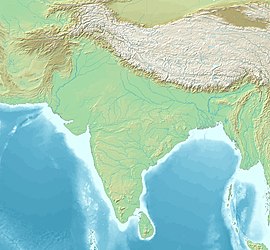| Art forms of India |
|---|
 |
The Art of Mathura refers to a particular school of Indian art, almost entirely surviving in the form of sculpture, starting in the 2nd century BCE, which centered on the city of Mathura, in central northern India, during a period in which Buddhism, Jainism together with Hinduism flourished in India.[5] Mathura "was the first artistic center to produce devotional icons for all the three faiths",[6] and the pre-eminent center of religious artistic expression in India at least until the Gupta period, and was influential throughout the sub-continent.[7]
Chronologically, Mathuran sculpture becomes prominent after Mauryan art, the art of the Mauryan Empire (322 and 185 BCE).[8] It is said to represent a "sharp break" with the previous Mauryan style, either in scale, material or style.[8] Mathura became India's most important artistic production center from the second century BCE, with its highly recognizable red sandstone statues being admired and exported all over India.[8] In particular, it was in Mathura that the distinctive Indian convention of giving sacred figures multiple body parts, especially heads and arms, first became common in art around the 4th century CE, initially exclusively in Hindu figures, as it derived from Vedic texts.[6]
The art of Mathura is often contrasted with the Greco-Buddhist art of Gandhara, which developed from the 1st century CE.[8] In particular, there is a debate about the origin of the Buddha image and the role played by each school of art. Before the creation of an image of the Buddha, probably around the 1st century CE, Indian Buddhist art, as seen in Bharhut or Sanchi, had essentially been aniconic, avoiding representation of the Buddha, but rather relying on its symbols, such as the Wheel of the Law or the Bodhi tree.
Mathura continued to be an important centre for sculpture until Gupta art of the 4th to 6th centuries, if not beyond. After this time much of the sculpture was of Hindu figures.
- ^ Cite error: The named reference
Bodhisattvas and Buddhas: Early Budwas invoked but never defined (see the help page). - ^ Annual report 1909-10. ASI. pp. 63–65.
- ^ Cite error: The named reference
PDM122was invoked but never defined (see the help page). - ^ Harle, James C. (1994). The Art and Architecture of the Indian Subcontinent. Yale University Press. pp. 63–64. ISBN 978-0-300-06217-5.
- ^ Paul, Pran Gopal; Paul, Debjani (1989). "Brahmanical Imagery in the Kuṣāṇa Art of Mathurā: Tradition and Innovations". East and West. 39 (1/4): 111–143. JSTOR 29756891.
- ^ a b Srinivasan, 4
- ^ "But what made Mathura pre-eminent among its peers, is the incomparable role it played as a major centre of religious art as well. Indeed no other ateliers are known to have produced at the same time so many images pertaining to all the three principal religious system of India: Brahmanism, Buddhism and Jainism. The unquestionable supremacy of the Mathura sculptor, at least till the beginning of the Gupta period, is further documented by the discovery of his handiwork from far-flung points of the Indian subcontinent" in Paul, Pran Gopal; Paul, Debjani (1989). "Brahmanical Imagery in the Kuṣāṇa Art of Mathurā: Tradition and Innovations". East and West. 39 (1/4): 111–143. JSTOR 29756891.
- ^ a b c d Cite error: The named reference
RS436was invoked but never defined (see the help page).


